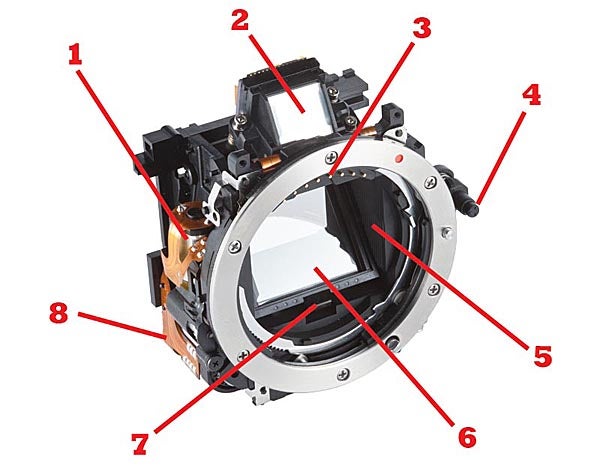The Guts: Sony Alpha 55 and 33 Translucent Mirror
We take a look inside Sony's new fixed mirror system.

We may earn revenue from the products available on this page and participate in affiliate programs. Learn more ›
While Sony uses the term “Translucent Mirror Technology” for its new Alpha 55 and 33, the mirror isn’t technically translucent. If it were, only diffused light, not detailed images, would pass through. Instead, most of the light passes through to the image sensor, and just a little reflects up to the AF sensor, allowing continuous phase-detection AF while shooting.
1. APERTURE RING DRIVE MOTOR: This rotates the lensmount aperture ring to control the lens iris.
2. PHASE-DETECT AF SENSOR: Behind this mirror is an optical sensor which measures subject-to-camera distance, then determines the amount and direction that the lens should adjust focus.
3. LENS COMMUNICATION CONTACTS: These create a communication path between the camera and lens CPU. For lenses that have their own internal AF drive, they also supply power for the drive.
4. LENS RELEASE LEVER: Push this to move the lens lock pin when you want to remove the lens from the camera’s mount. It also disengages the AF drive cam.
5. MIRROR BOX: Houses the Translucent Mirror, the focal plane shutter, and the lensmount mechanism.
6. TRANSLUCENT MIRROR Made to high manufacturing tolerances, the stationary Translucent Mirror passes almost all of the light through to the image sensor and a small portion to the AF sensor, allowing AF operation even during image recording.
7. TRANSLUCENT MIRROR LOCK LEVER: This button allows the translucent mirror to be manually swung up for sensor cleaning.
8. AUTOFOCUS DRIVE MOTORFor lenses without an internal AF drive, this motor provides focus drive through the AF drive cam.